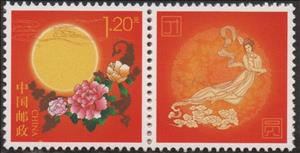Stamp with Attached Label: Moon and Peonies (China, People's Republic 2013)
Moon and Peonies (China, People's Republic 2013)
26 August (China, People's Republic ) within release Official Personalized Stamps goes into circulation Stamp with Attached Label Moon and Peonies face value 1.20 Chinese renminbi yuan
| Stamp with Attached Label Moon and Peonies in catalogues | |
|---|---|
| Michel: | Mi: CN 4508Zf |
| Stamp Number: | Sn: CN 4138 |
| Stanley Gibbons: | Sg: CN 5803 |
Stamp with Attached Label is horizontal format.
Also in the issue Official Personalized Stamps:
- Stamp with Attached Label - Moon and Peonies face value 1.20;
- Stamp with Attached Label - Old Sailing Ship face value 1.20;
Stamp with Attached Label Moon and Peonies it reflects the thematic directions:
A flower, sometimes known as a bloom or blossom, is the reproductive structure found in plants that are floral (plants of the division Magnoliophyta, also called angiosperms). The biological function of a flower is to effect reproduction, usually by providing a mechanism for the union of sperm with eggs. Flowers may facilitate outcrossing (fusion of sperm and eggs from different individuals in a population) or allow selfing (fusion of sperm and egg from the same flower). Some flowers produce diaspores without fertilization (parthenocarpy). Flowers contain sporangia and are the site where gametophytes develop. Many flowers have evolved to be attractive to animals, so as to cause them to be vectors for the transfer of pollen. After fertilization, the ovary of the flower develops into fruit containing seeds. In addition to facilitating the reproduction of flowering plants, flowers have long been admired and used by humans to beautify their environment, and also as objects of romance, ritual, religion, medicine and as a source of food.
The Moon is Earth's only natural satellite. It orbits at an average distance of 384,400 km (238,900 mi), about 30 times the diameter of Earth. Tidal forces between Earth and the Moon have over time synchronized the Moon's orbital period (lunar month) with its rotation period (lunar day) at 29.5 Earth days, causing the same side of the Moon to always face Earth. The Moon's gravitational pull – and to a lesser extent, the Sun's – are the main drivers of Earth's tides.


